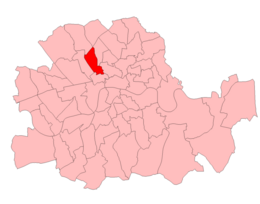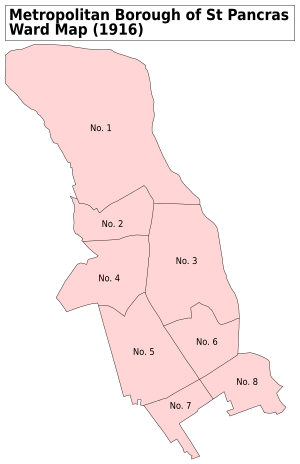Quick facts for kids {{{Name}}}
[[{{{Type}}} constituency]] |
[[Image:{{{Map1}}}Constituency.svg|120px|]]
[[Image:England{{{Map2}}}.svg|120px|]] |
| {{{Name}}} shown within [[{{{Entity}}}]], and {{{Entity}}} shown within England |
| Created: |
{{{Year}}} |
| MP: |
{{{MP}}} |
| Party: |
{{{Party}}} |
| Type: |
House of Commons |
| County: |
[[{{{County}}}]] |
| EP constituency: |
[[{{{EP}}} (European Parliament constituency)|{{{EP}}}]] |
St. Pancras South East was a borough constituency represented in the House of Commons of the Parliament of the United Kingdom. It elected one Member of Parliament (MP) by the first past the post system of election. It was created in 1918 by the division of St Pancras South into South East and South West divisions, and abolished in 1950.
Politics and history of the constituency
Boundaries

St Pancras South East in London 1918-50
1918–1950: The Metropolitan Borough of St Pancras wards of six and eight, and the part of ward number three lying to the south and east of a line running along the middle of Camden Road from a point where that road is intersected by the eastern boundary of the metropolitan borough to the point where that road crosses the Regent's Canal and thence westward along the middle of that canal to the western boundary of Ward number three.
In 1950 the constituency was split between Holborn and St Pancras South (wards Six and Eight) and St Pancras North (ward Three).
Members of Parliament
Elections in the 1910s
* Some records describe Adams as an Independent, while others state that Adams, Hopkins and Reiss all supported the Coalition Government. One states that Coalition Government endorsement was initially issued to Reiss but subsequently withdrawn.
However, Craig records that Adams initially received the coupon with Liberal endorsement, and this was later withdrawn, with Craig claiming to be free of any party allegiance and previously having been outspokenly against the coalition.
Elections in the 1920s
| General election 1922: St Pancras South-East |
| Party |
Candidate |
Votes |
% |
±% |
|
Unionist |
John Hopkins |
8,753 |
47.5 |
+9.7 |
|
Labour |
Herbert Romeril |
5,609 |
30.5 |
+13.6 |
|
Liberal |
Leonard Franklin |
4,053 |
22.0 |
-5.8 |
| Majority |
3,144 |
17.0 |
+7.0 |
| Turnout |
18,415 |
60.1 |
+12.9 |
|
Unionist hold |
Swing |
|
|
| General election 1924: St Pancras South-East |
| Party |
Candidate |
Votes |
% |
±% |
|
Unionist |
John Hopkins |
12,538 |
54.5 |
+16.6 |
|
Labour |
Herbert Romeril |
10,463 |
45.5 |
+3.9 |
| Majority |
2,075 |
9.0 |
+5.3 |
| Turnout |
23,001 |
72.6 |
|
|
Unionist hold |
Swing |
|
|
| General election 1929: St Pancras South East |
| Party |
Candidate |
Votes |
% |
±% |
|
Labour |
Herbert Romeril |
13,173 |
47.9 |
+2.4 |
|
Unionist |
Alfred Beit |
10,543 |
38.3 |
-16.2 |
|
Liberal |
Elizabeth Edwardes |
3,798 |
13.8 |
New |
| Majority |
2,630 |
9.6 |
N/A |
| Turnout |
30,144 |
66.8 |
-5.8 |
|
Labour gain from Unionist |
Swing |
+9.3 |
|
Elections in the 1930s
| General election 1935: St Pancras South East |
| Party |
Candidate |
Votes |
% |
±% |
|
Conservative |
Alfred Beit |
11,976 |
51.0 |
-15.7 |
|
Labour |
Santo Jeger |
10,340 |
44.0 |
+11.9 |
|
Liberal |
Laurence George Bowman |
1,181 |
5.0 |
New |
| Majority |
1,636 |
7.0 |
-27.6 |
| Turnout |
23,497 |
60.4 |
-5.1 |
|
Conservative hold |
Swing |
|
|
Elections in the 1940s



